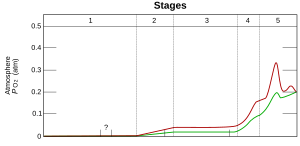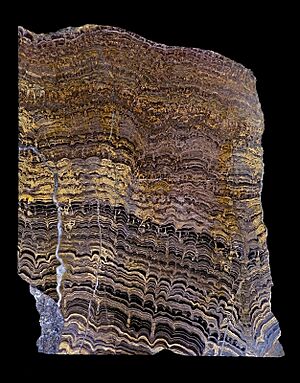Palaeoproterozoic facts for kids
The Palaeoproterozoic was the first big chunk of time in the Proterozoic eon. It started after the Archaean eon and lasted a very long time, from about 2,500 to 1,600 million years ago.
During this time, tiny living things called cyanobacteria made lots of stromatolites. Also, the first single-celled eukaryote organisms appeared. These are cells with a nucleus, like the ones in our bodies.
The Earth's first supercontinent formed during this era. Some of the rocks from this time were normal sedimentary rocks, not changed by heat and pressure like metamorphic rocks.
Contents
Earth's Early Days
The Earth was much younger back then, so things were different from today. The inside of the Earth was hotter. This was mainly because there were more radioactive elements that slowly decay over time.
The surface temperatures were also higher. This was due to heat coming from inside the Earth. Also, the atmosphere had a strong greenhouse effect from gases like methane and carbon dioxide. In the earlier Archaean eon, the oceans were very hot, around 55–85 °C (131–185 °F)! The Sun was not as strong back then, which helped balance some of this heat.
Scientists think that about 1.8 billion years ago, a year had about 450 days. This means each day was shorter, lasting about 20 hours. Even further back, a day was only about 17 hours long, and there were about 514 days in a year! The Moon was also closer to Earth back then.
The First Supercontinent
A huge global landmass, called Columbia (or Nena), existed during the Palaeoproterozoic era. It was around from about 1.8 to 1.5 billion years ago. Imagine one giant continent on Earth!
Earth's Changing Climate
The climate during this era changed a lot. It started very hot, but then there were three massive ice ages. During these ice ages, ice covered much of the Earth, even reaching into the tropics.
Methane Levels Dropped
Scientists have found clear signs that the amount of methane in the air dropped during this era. Methane is a strong greenhouse gas. The big drop in methane from the Archaean atmosphere likely played a huge role in two things:
- The rise of oxygen.
- The start of the Palaeoproterozoic ice ages.
Data shows that around 2.4–2.3 billion years ago, a major event happened called the ‘Great Oxygenation Event’. This is when Earth's surface environment changed completely and forever.
Oxygen Started to Build Up

Oxygen was made by the cyanobacteria. But for a long time, most of this oxygen was used up by chemicals in the environment, like unoxidized sulfur and iron. Until about 2.3 billion years ago, the amount of oxygen in the air was probably only 1% to 2% of what it is today.
Many of the world's iron ore deposits were formed when oxygen combined with iron. Most of these formations stopped appearing after 1.9 billion years ago. Also, Red beds, which are rocks colored red by hematite (a type of iron rust), show that oxygen in the air increased after 2 billion years ago. You won't find these red rocks in older layers.
The Great Ice Ages
There were three major ice ages during this era. Ice covered large parts of the Earth, even reaching warm tropical areas. These ice ages likely happened because there were fewer greenhouse gases in the atmosphere and more oxygen being produced.
Scientists have noticed something interesting: there was a long period of about 1,400 million years with no confirmed ice ages. This was between the early Palaeoproterozoic glaciations (around 2400–2200 million years ago) and the later Neoproterozoic glaciations (around 800–600 million years ago).
Meteorite Impacts
There were also some very large meteorite impacts during this era. Two of these created the biggest impact craters ever found on Earth. There were also three smaller impacts (craters 30 kilometers or more across) between 3.0 and 1.2 billion years ago.
How Eukaryotes Appeared
The development of the eukaryotic cell was a huge step in the story of life. Eukaryotic cells are complex cells that make up all multi-celled organisms, including us! It's hard to know exactly when this happened, but scientists like Knoll suggest it was roughly 1.6–2.1 billion years ago. Some early acritarchs (tiny, single-celled fossils) have been found from at least 1650 million years ago. Also, a possible type of alga called Grypania has been found as far back as 2100 million years ago.
| Precambrian (4.567 gya – 541 mya) | |
|---|---|
| In the left column are Eons, bold are Eras, not bold are Periods. gya = billion years ago, mya = million years ago | |
| Hadean (4.567 gya – 4 gya) | Chaotian Zirconian |
| Archaean (4 gya – 2.5 gya) | Eoarchaean (4 gya – 3.6 gya)
Palaeoarchaean (3.6 gya – 3.2 gya) |
| Proterozoic (2.5 gya – 541 mya) | Palaeoproterozoic (2.5 gya – 1.6 gya) Siderian (2.5 gya – 2.3 gya) Rhyacian (2.3 gya – 2.05 gya) Orosirian (2.05 gya – 1.8 gya) Statherian (1.8 gya – 1.6 gya)
Mesoproterozoic (1.6 gya – 1 gya) Calymmian (1.6 gya – 1.4 gya) Ectasian (1.4 gya – 1.2 gya) Stenian (1.2 gya – 1 gya) Neoproterozoic (1 gya - 541 mya) Tonian (1 gya – 720 mya) Cryogenian (720 mya – 635 mya) Ediacaran (635 mya – 541 mya) |
See also
In Spanish: Paleoproterozoico para niños


